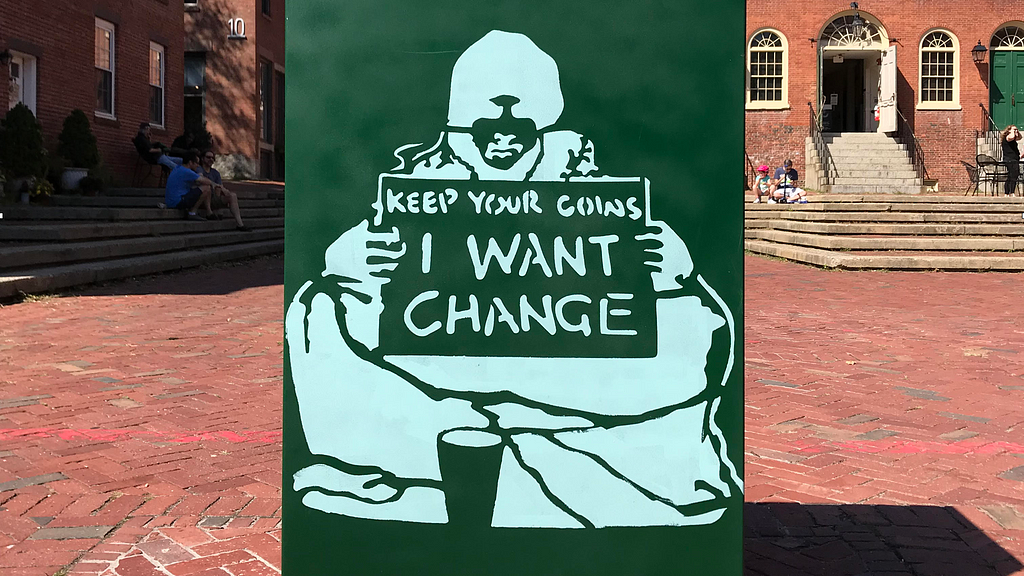Blogs & Articles: Is the crypto revolution failing? 🔗 3 years ago

- Category: Blogs & Articles | Alex Gladstein on Medium
- Author(s): Alex Gladstein
- Published: 27th September 2021 16:49
 Street art in Salem, Massachusetts
Street art in Salem, Massachusetts
Today crypto seems like an insider’s game for the rich and powerful, not a grassroots movement.
The idea incepted by Satoshi Nakamoto of a peer-to-peer electronic cash system beyond the control of governments and corporations can seem like a distant memory when scanning news about today’s top cryptocurrency projects.
Dogecoin — which caught mainstream attention after generating an 85x return over the past 12 months — has turned corporate, launching a new advisory board starring Ethereum creator Vitalik Buterin and an individual representing the coin’s top promoter, Elon Musk.
Stablecoins pegged to the dollar like USDC and exchange tokens like Binance Coin are issued and operated by companies that work closely with governments and enforce regulations and blacklists. What’s more, in action stablecoins do more to promote the popularity of the US dollar abroad than usher in any kind of fundamental monetary upheaval.
The most popular projects built on Ethereum are now either captured by special interests or coming under regulatory pressure. For example, the protocol’s star app, Uniswap, is under investigation by the Securities and Exchange Commission. The company has lawyered up, hiring a Chief Legal Officer who previously represented Apple and Google.
According to the Global DeFi Adoption Index, growth in DeFi has been primarily powered by “experienced cryptocurrency traders and investors looking for new sources of alpha in innovative new platforms,” with large institutions dominating transaction volume.
In NFT land, the three most popular issuers by volume are regulatable companies — Larva Labs, Art Blocks, and Yuga Labs — not decentralized autonomous organizations. As for the most popular marketplace (Open Sea) — it is not a DAO either, but rather a company whose head of product was recently accused of insider trading.
Andreessen Horowitz partner Chris Dixon posted a long Twitter thread the other day, hyping the decentralized and tokenized Web 3.0. When I pointed out that the projects he is pushing stand as of today to benefit not the masses but a tiny group of investors like himself, he blocked me instead of engaging.
Governments are now even entering the arena and creating their own cryptocurrencies called Central Bank Digital Currencies. The Chinese Communist Party has already rolled out its GovCoin to millions of people, while the EU has been vocal about the progress of its “digital euro” project, and even the US government has discussed the idea of FedCoin as a matter of when and how, not ‘if.’
Given the current state of affairs, it is fair to ask: was the cypherpunk dream a sham?
Was it for riches after all, in a game where principles were dispensable and where negotiations with the state and corporatization were inevitable?
Few want to acknowledge and have an open conversation about this dilemma, where the main impact of “crypto,” Web 3.0, and DeFi has been to recreate a Wall Street system of Cantillon insiders, enrich a tiny few institutions and VCs often at the expense of retail token buyers, and extend the dollar’s popularity around the world.
Can we still separate money and state and create an alternative system to corporate bailouts and mass financial surveillance? Where is Satoshi’s political revolution?
The answer is: in Bitcoin.
Over the past 18 months, the original cryptocurrency has risen from lows near $3,600 to a peak of $64,000 and now sits around $45,000. Critics mock its 35% decline in value from its all-time high in April but seem blind to the fact that it is up 250% in the past year.
This striking increase in purchasing power contrasts dramatically with the trend in fiat currencies worldwide, which have suffered in the same time frame a loss of anywhere from 3–5% in purchasing power for the euro or the dollar, to losses in the double, triple, or even quadruple-digit range for fiat issued by governments in Nigeria, Turkey, Argentina, Lebanon, Ethiopia, and Venezuela.
In a world where 1.2 billion people live under extreme inflation, Bitcoin’s slow but steady increase in purchasing power over time for its users has been a literal lifeline for millions.
According to recent exchange data, there are millions of Bitcoin users in major emerging market countries including India, Nigeria, and Turkey. Globally, lower-bound estimates from Q1 of this year placed Bitcoin on-chain plus exchange users near the 135 million mark. Given the asset’s constant growth since January, it seems reasonable to estimate a current user base of around 200 million, or around 2% of the world population.
Critics point out that other cryptocurrencies or corporate stocks have either outperformed or performed within Bitcoin’s range over the past few years. This is certainly true — one only need look at the recent astronomical rise in value of Dogecoin or Solana — but the reality is altcoins have historically crashed much harder than Bitcoin during bear markets, and none of them are as easily convertible to fiat money where it matters most.
Today, in any major urban area on earth, one can quickly find a buyer for Bitcoin, either through centralized exchanges or peer-to-peer marketplaces. This is as true in Havana as it is in Gaza or Minsk. The same cannot be said for Dogecoin, Solana, or Amazon stock.
And this is where the real revolution emerges, against a backdrop of a world where most cryptocurrencies, equities, real estate, and bonds have mostly enriched a small group of wealthy or connected insiders.
How many retail traders were loading up on Solana in December of 2020, waiting to capture its 128x rise in value and then perfectly selling into something more stable at the top? The answer is not many, as most Solana holders FOMO’d in along the way, catching a relatively small increase in value compared to the extreme benefit of a tiny few insiders and creators and early VCs.
In contrast, millions of people have been buying Bitcoin in small amounts for years. Just to zoom in on the United States, as of a Q1 2021 Square financial report, Cash App reported 3 million Bitcoin buyers in 2020 and 1 million new buyers in January 2021. When Coinbase and Kraken’s 50 million users are also considered alongside public polling, it seems likely that there are more than 10 million active US Bitcoin buyers. And America constitutes just 4% of the world population.
Often dismissed as old hat, or even “boomer coin” by the legions of today’s NFT collectors, Bitcoin is, deep down, where things remain radical.
The Bitcoin protocol remains controlled by its users, not by any corporation or special interest group. A quick look at the top-10 cryptocurrencies reveals several that are obviously controlled by a company and thus have a single point of failure: Binance Coin, Solana, Tether, USDC, and XRP. The rest remain heavily influenced or even outright controlled by their creators: Polkadot, Cardano, Ethereum, and Dogecoin.
Special interests did try to capture Bitcoin in 2017, in an episode known as the Blocksize War. Here, corporations boasting more than 20 million users on their platforms teamed up with miners boasting more than 80% of the global mining capacity to try and force a rule change into the protocol to increase the block size, in an effort to get more on-chain transactions per second. Stunningly, Chinese billionaires and Silicon Valley and Wall Street heavyweights were defeated by a grassroots movement of users, who proved they hold final say in Bitcoin.
Miners can mine whatever blocks they like, and companies can make whatever suggestions they want to the protocol — it is open, after all — but tens of thousands of decentralized users running the Bitcoin software at home, scattered across the globe, ultimately decide which blocks are valid and which software to run. This means, in practice, that no matter one’s wealth, status, nationality, gender, beliefs, or location, all users are equal in the eyes of the code. There are no insiders who hold special powers.
This coming November, Bitcoin’s latest major software upgrade “Taproot” will activate, enabling powerful new smart contracting, usability, security, and privacy improvements for Bitcoin engineers to implement over the coming 18–24 months. Unlike an update from Microsoft, for example, no corporation dictated terms. There was no hard fork, forced by developers onto a user base. Instead, the community reached consensus in a slow (upgrades like this only happen every few years) but steady way. If users do not like Taproot, they do not have to run it. Their Bitcoin software will continue to work fine, and their BTC will still be spendable and receivable by any other user.
The marriage of user control, resilience, and global network effects has helped Bitcoin start to change the global financial system in measurable ways.
What many casual observers do not realize is that Bitcoin is not merely competing with Visa or Mastercard, but rather with the dollar itself. Its aim is not just to process a certain number of transactions per second, but rather, to be digital cash for the world, with value secured not by national fiat, but by a peaceful, non-coercive algorithmic alternative to central banking. Its goal is to be the open and neutral money that our discriminatory world desperately needs.
Even as a currency, it is making significant and even shocking strides. In the past 12 months we have seen the rise of two new Bitcoin narratives: corporate balance sheet adoption and nation-state adoption.
These developments were predicted by the Bitcoin community as far back as 2009 message board speculation between Satoshi Nakamoto and cypherpunk Hal Finney — “it might make sense to get some just in case it catches on” wrote Finney in 2009 — but few thought they would materialize so soon.
Ever since Microstrategy at Michael Saylor’s direction purchased hundreds of millions of dollars worth of Bitcoin in the summer and fall of 2020, dozens of other public and private companies (including Tesla and Square) and even ETFs and countries have added Bitcoin to their balance sheet as a reserve asset.
The general idea is, if we are in a macroeconomic climate that implies inflation over the next few years, convert some percentage of your cash on hand to Bitcoin — the only debasement-proof digital asset— as a hedge. If the climate shifts and we experience tapering of private sector purchasing from central banks and rising interest rates, and Bitcoin falls, then the rest of your reserve will keep you afloat. This diversification strategy is something more and more corporate treasurers are pursuing.
Why not gold, some ask? Despite the record amount of money printed by central banks in the past decade, gold has been relatively flat. It simply has not acted as a good hedge against unprecedented monetary inflation. Meanwhile, Bitcoin has in that same climate gone from just a few pennies to tens of thousands of dollars, outperforming every other major asset class in the world, including every other cryptocurrency. Since July 2010 Bitcoin is up 65 million percent against the dollar. $100 invested in Bitcoin at that time would now be worth $65 million, adjusted for inflation: the most impressive performance of any fungible asset in history.
Mainstream media like The Economist and The Financial Times might be infatuated with NFTs and DeFi at the moment, but it is Bitcoin’s performance over time and continued ability to bounce back from 80–90% crashes in value that is starting to change minds in the financial world. People love collectibles and trading exotic assets, but not nearly as much as they love money. This can be measured simply by the daily volume of trading amongst cryptocurrencies: the majority of volume — more than 60% — is with Bitcoin, copies of Bitcoin, and stable coins, versus smart contracting or NFT platforms.
Even more striking than increasing investment into Bitcoin from the private sector is nation state adoption. In June, El Salvador shocked the world when it announced it would make Bitcoin legal tender. Economists have long mocked Bitcoin as “not money” because it is “not legal tender” anywhere. That argument has now expired. For 6.5 million Salvadorans, as of September 7th, Bitcoin is legal tender. This means they do not have to pay capital gains if it increases in value against the dollar; that they can pay back debts at banks or with the state with Bitcoin; and that merchants are obliged, over time, to accept the currency.
From the perspective of human rights, the topic is more nuanced. Yes, it is remarkable that a nation has opted to make open-source, decentralized currency its legal tender. But the president of the El Salvador has turned increasingly authoritarian and has pulled the law into force in just a matter of months, over a population that knows virtually nothing about Bitcoin.
El Salvador’s decision remains hotly contested, but it will not be the only country to adopt Bitcoin. Already, Ukraine, Panama, and Paraguay are discussing national Bitcoin adoption, while sovereign wealth funds ranging from Singapore to Norway to Switzerland currently hold either Bitcoin or investment in Bitcoin companies on their balance sheets. What remains notable is that El Salvador’s law is a Bitcoin law, not a “crypto” law. Solana and Dogecoin are not legal tender in El Salvador, and one of the key reasons is the Lightning Network.
Launched in 2018 to help Bitcoin become instant, cheap, and more privacy-protecting, Lightning enables people today to send Bitcoin to each other in a peer-to-peer fashion in seconds, for just fractions of a penny. The Salvadoran government based its reasoning for introducing Bitcoin as legal tender on the back of Lightning as payment network to improve remittances. And just a few days ago, Twitter began to roll out a “tip jar” feature where creators will be able to eventually receive Lightning tips from any of the app’s quarter-billion daily active users.
Just as Bitcoin is convincing companies and governments to adopt it, human rights activists and journalists continue to use it as a parallel banking system free from censorship, remote confiscation, and blacklists. Human rights defenders everywhere from Russia to Nigeria to Belarus have found in Bitcoin a remarkable empowerment tool. And millions of people in emerging markets, regardless of profession or political inclination, have turned to Bitcoin as a life raft in a sea of broken fiat.
Bitcoin critics tend to a) underestimate the impact the currency has made on the establishment, b) underestimate the long-term impact of Bitcoin’s immutable monetary policy versus the fluctuating and relatively flexible monetary policy of all other cryptocurrencies, and c) ignore or dismiss how Bitcoin is giving financial freedom to millions in the Global South and in authoritarian societies.
As Greg Barker recently wrote for Unherd — in a good summary of existing Bitcoin criticism — “rather than producing a more open, more liberating, more financially free society, the crypto movement has empowered not just another cabal of corrupt financiers, but a hidden cartel of criminals, Wall Street rejects, and what U.S Senator Liz Warren has described as “shadowy super-coders.”
Again, this might be true for “crypto” — whose overall outcome as of today might disappoint those seeking to disrupt the establishment — but it misses the mark on Bitcoin, which, as you read this, is aiding millions who simply do not have access to better money.
Barker continues: “some of the crypto elite have started to question whether true decentralisation is a delusion. Indeed, they are starting to realise that it is a lot easier to build a fortune — and keep it — when they participate in the “official” system and follow the rule[s].”
This is also true of altcoins. They are, overwhelmingly, buckling to government pressure, from USDC to Uniswap.
As SEC chairman Gary Gensler has pointed out, many of these projects are “DINO”: decentralized in name only. And anything that has a centralized group of controllers will be pursued by the long arm of the law. The state attack will eventually come, and it will subsume, defang, or shut down whatever it can. This is probably one major reason Satoshi disappeared when Bitcoin was worth just a few dollars and was barely more than a science experiment.
Barker concludes: “rather than simply throwing in the towel and admitting the game is up, they have abandoned their cyber-libertarian roots and merged with their enemy: the financial behemoths of Wall Street, the Federal Reserve and Silicon Valley.” Again, true for most cryptocurrencies. But not of Bitcoin, which, instead of making concessions to the establishment, is dictating terms.
Many companies and entities in the cryptocurrency space are in it for rent-seeking, not liberty. But the game theory behind Bitcoin was structured to exploit this element of human nature.
Most people who buy Bitcoin do not care about — or do not even realize — how it can help dissidents. They overwhelmingly adopt it as a speculative store of value that they hope will protect their savings against inflation over time. But whether they like it or not, these individuals are strengthening the global network effect of a monetary technology that is challenging an exclusionary and unjust incumbent financial regime.
Bitcoin is the biggest peaceful protest the world has ever seen. With more than a hundred million users quietly opting out of the current financial system into a new one — based not on war and oil but on non-violence and math — we are at the beginning of radical change.
With Bitcoin, individuals are taking power back from the state. They are becoming their own banks, seizing their own freedoms, avoiding debasement and censorship, and becoming sovereign individuals. Not 10 years from now, but today.
Bitcoin’s current user base is comparable by percentage of the global population to the user base of the internet in 1997, when 150 million people were online. In the following decade, technology advanced from dial-up modems to the iPhone.
What do the coming 10 years hold for Bitcoin? What will the world look like in 2031?
No one can see the future, but as of today, Bitcoin is very much on track to provide citizens of the world with a plan B: an alternative monetary system that anyone can access and that protects against the inflationary and predatory financial experiments of our governments.
Even as “crypto” continues to deliver the biggest returns to insiders and even as it strengthens, rather than shakes, the existing financial establishment, Bitcoin is beginning to deliver a real revolution.






